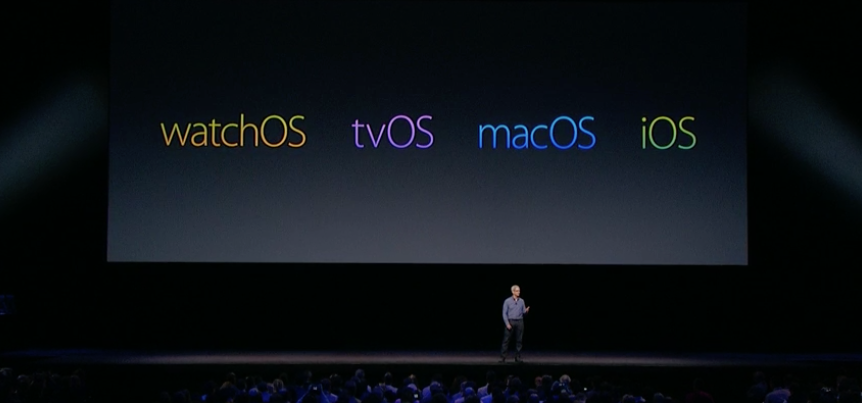
Apple kicked off its World Wide Developers Conference (WWDC) this year by introducing big updates to its four major platforms: watchOS, which powers Apple Watch; tvOS, the driver behind Apple TV; OS X, the desktop operating system running all Macs; and iOS, the mobile operating system that gives life to iPhones, iPads, and iPod touches. These platforms see updates on a regular basis every year, but with WWDC in town, they aim to change the game in ways in could only imagine. You may be disappointed to hear there were no hardware unveils this time around, but fret not because these software updates demoed today are worthy of their own stage. The breakdown is after the break.
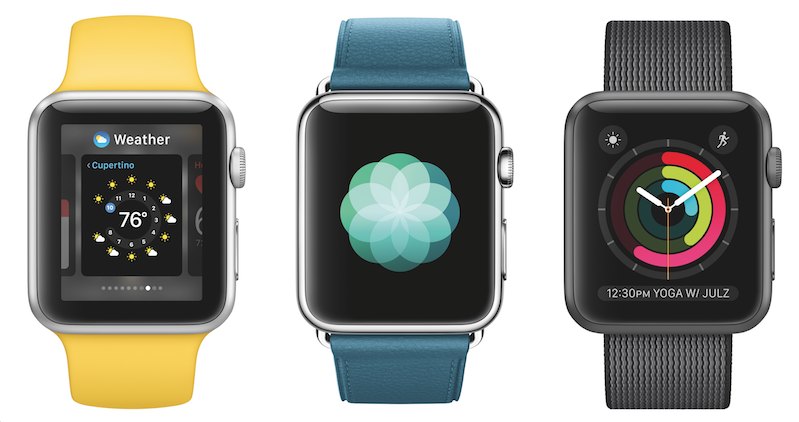
watchOS 3
- App performance on Apple Watch is faster than ever before. Click an app and BOOM an app is instantly loaded and updated. The loading wheel most users are used to seeing today will soon be a thing of the past.
- The Side button has a new function. Instead of bringing up a carousel of favorite friends, it will provide quick access to your most frequently used apps. The card-based UI borrows its look from the multitasker found in iOS; swipe left and right to glance at live apps and tap one to open it. Glances, in a sense, are gone. This customizable, live app switcher replaces it.
- So what happens when you swipe up on your watch face, then? Goodbye Glances, hello Control Center. Again, borrowing from iOS, watchOS now has its very own Control Center with easy access to battery level, airplane mode, silent and Do No Disturb switches, Ping iPhone, and lock device. Swiping from the top of the watch face still brings down the Notification Center. In sum, the user interface and user experience on the Watch is made to match what you’ve been used to for years on your iPhone.
- Replying to messages is a much simpler task now. Instead of locating and tapping Reply, now you simply tap the way in which you want to reply. You’ll find icons for dictation, emoji, and Digital Touch at the bottom of a conversation. Smart replies are there, too. A new feature called Scribble allows you to use your finger to draw letters and the watch will immediately translate them into text for you to send off.
- Of course there are new watch faces to play around with. Minnie Mouse joins her counterpart on the Watch, and users can customize her dress to watch the color of a band. A new Activity face brings your Activity Rings to the forefront and it’s available in analog, chronograph, and digital styles. A simple Numerals face highlights the hour of the day and nothing more, and this number’s font can be customized to your liking. Apple understands that some people enjoy swapping watch faces depending on time of day or dress; to switch between them now, simply swipe from edge-to-edge to switch between your customized faces whenever you like. Also, when customizing your watch faces, you’ll note added complication support; for example, the Photo face now features weather conditions.
- New first-party app alert! Reminders and Find Friends now live in the Watch’s app cluster, and they work just like their iOS counterparts.
- In emergency situations, Apple’s made it easy to contact 911 directly from your wrist, regardless of the fact if you have your phone with you. Press and hold the Side button to bring up a menu housing switches for powering off your device, viewing your Medical ID, and dialing Emergency SOS. Continue to hold down the button and Emergency SOS will activate on its own; a countdown timer will result in a call placed to your emergency center. If you lack cellular service, the call will go through over WiFi. Additionally, a message bundled with your current location will be sent to your predetermined list of emergency contacts. Your Watch will then bring up your Medical ID information so when help arrives on the scene, they’ll have relevant information to go on. Apple says the new feature works both domestically and internationally.
- The Activity app is getting a social boost with a new feature called Activity Sharing. Swipe your rings to the left to reveal a new section that’s all about comparing and competing with your friends and family. If they allow it, you’ll be privy to their rings and achievements across the Activity and Workout apps, as well as third-party fitness apps. You can send “smack talk” to your competition inside the Activity app by dictating messages or choosing from a list of pre-made ones. Elsewhere, the app has been tweaked for disabled wearers; if you utilize a wheelchair, you’ll notice the Activity and Workout apps have been optimized for you. For example, “time to stand” notifications have been altered to say “time to roll.” It’s a nice touch. There’s also a new health-related app called Breathe that provides simple, deep breathing exercises. Elegant UI guides you through them, and if you want to do them with your eyes closed, gentle haptic feedback will take you through the process. If your job stretches you thin, Apple hopes that a “time to breathe” notification will drop your stress level, even if just for a moment.
- It’s a developer’s conference after all, so Apple made a giant chunk of its audience happy today by announcing new APIs. Essentially, devs will now have access to more tools to create better apps for the Watch. Apple Pay is supported in third-party apps, fitness app makers have access to background workouts, real-time heart rate, the gyroscope and all-day accelerometer, among other things.
- A developer preview of the new watchOS is out today, and a free upgrade for all Watch users will release this fall.
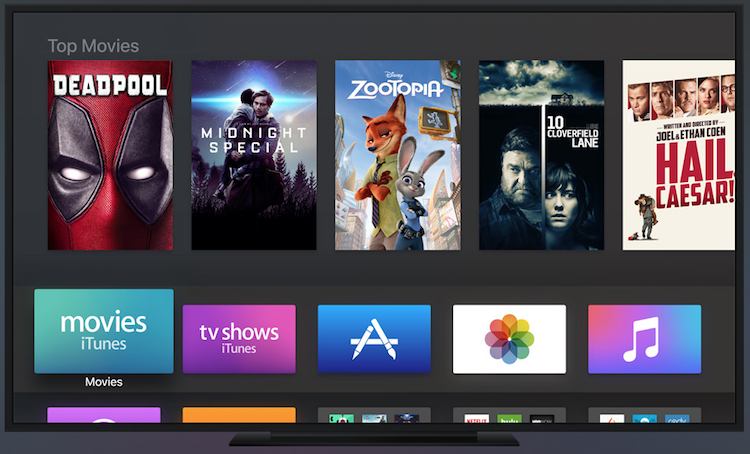
tvOS 2
- There are over 6,000 native apps made for Apple TV today, and a few more exciting ones are on the way. If you subscribe to Sling TV, you can now access it on Apple TV. Other apps coming soon include Fox Sports Go, Molotov, NBA 2K, Minecraft Story Mode, and Sketch Party.
- A new version of the Remote app for iOS brings Siri Remote functionality to your iOS devices. A touch panel replicates the glass panel found on the Apple TV’s remote used to navigate the user interface, and your iOS device’s accelerometer and gyroscope turn it into a gaming controller. You can shout commands into your device and Siri will respond in kind, or alternatively the keyboard is there to manually type search queries.
- Speaking of Siri and search, that’s all been updated on Apple TV to support topic search. So, for example, you can prompt Siri and say, “Find high school comedies from the 80s” and Ferris Bueller’s Day Off, among others, will be offered. You can also use Siri to search across YouTube now, too, as well as call up live feeds from your favorite streaming apps. Say “Watch ESPN 2” and Siri will bring up the live programming provided by the cable network. Of course, this feature will only work with those networks that offer live content, as opposed to the ones that only support on-demand streams. It’s called Live Tune-In and it’s coming to Apple TV and iPad.
- Here’s a big one. With single sign-on, you only have to enter your cable or satellite subscription credentials once on Apple TV to get immediate access to all the streaming apps in your pay TV package. In other words, you’ll no longer have to fear re-entering your credentials every time you download and install new streaming apps. Huzzah! Single sign-on is coming to Apple TV and iOS devices.
- A new dark mode allows you to swap the bright white background for a more theatre-like experience.
- Download a universal app like MLB At Bat on your iOS device and it will automatically download and install on your Apple TV.
- New APIs for devs including ReplayKit–the ability to live broadcast games or save video to share later, PhotoKit–access to iCloud Photo Library, and HomeKit–you’ll be able to control your connected devices at home (for example, telling Siri to dim the lights before starting a movie).
- A developer preview of the new tvOS is out today, and a free upgrade releases this fall.
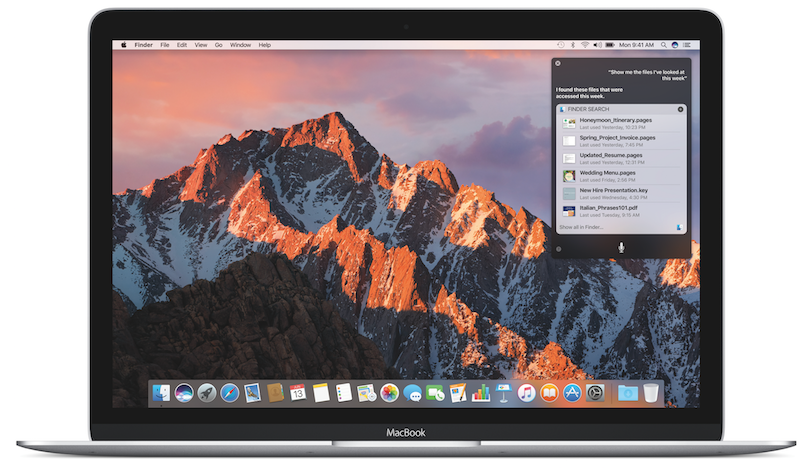
macOS Sierra
- Notice the change? After 15 years of using the OS X name, Apple is finally relinquishing it so that the its desktop operating system’s title falls in line with the rest of its platforms. OS X is now macOS and it lives in an ecosystem alongside watchOS, tvOS, and iOS.
- Continuity is making a major play in the next version of macOS dubbed Sierra. With Auto Unlock, your Mac will know when you’re in close proximity to your computer and when you wake it up, it will automatically unlock itself. The catch: the feature works exclusively with Apple Watch, for now. But here’s a cool one for all. With Universal Clipboard, you can copy text or images on one device, and paste it on another. For example, if you find a great image of a kangaroo on your iPhone that’s perfect for your school project, you can copy it and when you get home you can paste it into your Keynote presentation on your Mac. It’s a nifty feature that will certainly come in handy.
- You can now store Desktop and Documents files on your iCloud Drive to be accessed across your macOS and iOS devices.
- Ever get that pesky notification your Mac telling you you’re almost out of space? Apple’s come up with a great way for your computer to help you optimize your storage. Using a new, intuitive tool in System Preferences, you can make room for new files on your computer by keeping older ones in the cloud (for example, movies you’ve already watched can be moved to iCloud). Additionally, the tool will help you delete files you never use (for example, it can clear the cache in Safari and empty your Trash if you’re prone to letting it pile up).
- Apple Pay is coming to the web. When shopping online, participating retailers will provide an Apple Pay checkout option. Authenticate your purchase by touching the Touch ID sensor on your nearby iPhone or tapping your Apple Watch–Continuity to the rescue!
- Tabs are taking over. Multiple tab support–what you’re used to in Safari and Finder–is coming to all Apple apps as well as third party ones in Sierra. And the best part is that developers don’t have to do a thing–it’ll just work out of the box, so to speak. Navigating to many locations next week? Open multiple tabs in Maps to bounce between all your routes.
- Picture-in-picture is here, and it works just like it does on iPad.
- The best has been saved for last. At last, Siri comes to the Mac. The intelligent assistant lives as an icon in the Dock, as well as up top on the menu bar. Tap the icon and she’ll listen to your commands. And she can do it all, including sophisticated queries like, “Show the files I worked on last week about the offsite.” Then refine it with, “Just the ones Ken sent me that I tagged with draft.” She’s just as smart as she is on iOS devices, so in addition to searching your computer for files, she can also search the Internet for images, movie times, sports scores, and all the rest. You can even dictate text messages for her to send, and tell her to start playing an iTunes playlist. What’s really cool is that you can drag and drop search results directly from Siri to whatever you’re working on. For example, if she pulls up pictures of falcons, you can drag the one you like directly into a Pages document. You can also pin Siri search results to Notifications Center for easy access anytime.
- macOS Sierra’s developer preview is out today, a public beta is expected in July, and the consumer release drops in the fall.
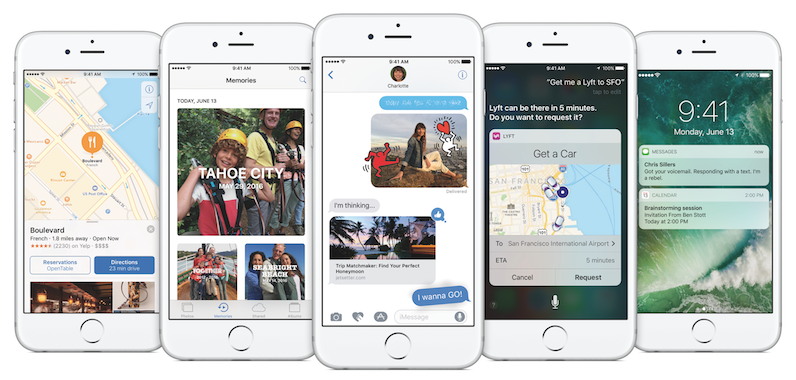
iOS 10
- The Lock screen is getting a major overhaul in the next major iOS release. When you pick up your iPhone, a new raise-to-wake feature will know when you’ve brought your device into view and show you the date, time, and whatever notifications you might have received since the last time you picked it up. In other words, you no longer have to press the home button or power button to prompt the Lock screen. Those Lock screen notifications are richer now; use 3D Touch to explore them and performs actions such as accepting an invite to an event. Swiping from the top down still brings Notification Center into view; use 3D Touch to clear all notifications with a single tap. Swiping up from the bottom introduces a streamlined Control Center. The usual suspects are here, but now you can swipe to the left to reveal two new sections dedicated to music playback and home automation. Other Lock screen interactions we’ve become accustomed to over the years are changing, too. Instead of swiping to unlock, you will now “Press Home to open.” You’ll have to press down on the Home button to unlock your device. Why the change? Swiping does something different now. Swipe to the left to enter Camera mode, and swipe to the right to reveal your widgets pane. Got it? Good.
- Once you are inside your phone, you’ll notice 3D Touch-compatible apps have been updated to include rich multimedia enhanced widgets. For example, force touch ESPN and you’ll see animations describing big plays in popular games happening now. From the 3D Touch menu, you can add choose to add a widget to the aforementioned widgets pane. Back in the widgets pane, you can view in-line video provided by the app makers; all in all, this makes for a richer, more interactive experience without having to even enter the app.
- Now that Siri’s been opened up to developers, you’ll be able to say things like, “Send a WeChat to Nancy saying I’ll be five minutes late.” Siri intelligence comes to the keyboard, too; if a friend asks where you are, the keyboard will offer up your current location for you to tap and send. Location, contact information, your calendar and recent address–Siri has the smarts to call these things up when you’re in a conversation.
- The Photos app has been enhanced with facial, object, and scene recognition technology. This’ll come in handy when performing specific searches and organizing your collection. A new section built into Photos called Memories has the power to scan your library and organize photos and videos into collections based on locations, dates, people and even topics like “at the beach.” Moments is coming to iOS, macOS, and tvOS.
- Maps‘ new design focuses on better navigation and search. And now it’s open to developers, giving you the ability to book a reservation using Open Table and request a ride using Uber, all without leaving the app.
- Music has changed for the better, too. Along the bottom you’ll notice streamlined icons for Library, For You (this is where Connect lives now), Browse (this takes over the New tab), Radio (including Beats 1), and Search. The UI has been redesigned from the ground up. The Now Playing page puts major emphasis on album artwork, and it even includes lyrics. You’ll see the new Apple Music design spread across iOS, macOS (read: iTunes), and tvOS.
- News also sees a design upgrade including new sections based on your reading habits. Subscriptions are supported, and breaking news notifications will clutter your Lock screen if you allow it.
- There’s a brand new app called Home that aims to make home automation a snap. If you’ve imagined a connected home with smart light bulbs, window shades, and locks, Home will be the destination for you to control it all. You can even set customizable “scenes” that communicate with multiple smart tech. For example, you can wake up in the morning, say “Hey Siri, good morning,” and that will prompt the “Good Morning” scene which may including turning on your lights and opening the shades. And it gets better. Home supports geolocation, so you can make it so that when you pull up into your driveway, your garage door will automatically open and your home will light up just the way you like it. The future is now, people. Home is coming to iOS, watchOS, and tvOS.
- Let’s not forget that the iPhone is also a phone, too! The Phone app is getting some love today, too, with Voicemail transcriptions, spam alerts, and VoIP integration. The former two are pretty self explanatory. With VoIP integration, an incoming call over Skype (or any third-party app of that nature) will look just like any old regular call coming through (as opposed to a boring notification alert).
- With the proliferation of messaging apps like Facebook Messenger and Snapchat, Apple knows it needs to turn the heat up and it’s doing just that with the new and feature-heavy version of Messages. We’ll start basic and expand from there. When you paste and share a link, it will be supported by an image and extracted title, just like what you’re used to on Facebook and Twitter. Sending a YouTube video? It can now be played in-line without having to open the YouTube app. When you click the Camera icon, in addition to seeing your recent photos and videos, you’ll see a live view of whatever your camera is currently pointing to. Love emojis? Now they’ll be presented 3x larger than before. Emoji predictions are coming, too; type out “My lips are sealed” and QuickType will present the lip-sealed emoji for you to tap. This one’s interesting, to say the least: After typing out a message, tap the emoji button and all words that are “emojifiable” (Apple’s word, not mine, natch!) will be highlighted in the text field and if you tap them they will magically be replaced by their corresponding emojis. Kids are going to LOVE this. There’s more, so much more. Tapbacks allow you to quickly react to incoming messages; think of them as Facebook’s Reactions and you can choose from a heart, thumbs up, thumbs down (Facebook, you had your chance with this one!), Ha Ha, “!!” and “?” Double-tap a message bubble to respond with a tapback reaction. Bubble effects and screen effects are new additions, too. Press and hold down the Send button to choose from bubble effects like Slam, Loud, Gentle, and Invisible ink. When you’re congratulating someone on something, for example, you might use the Slam effect; the recipient will see your bubble literally slam into your conversation. Gentle works when you’re saying, “I’m sorry.” I think you get the picture. Invisible ink is a cool gimmick; use it when you’re in the mood to surprise. Your recipient will have to use his or her finger to swipe the message to reveal it. Screen effects include ones that actually transform the entire background of your conversation with things like balloons and confetti. Handwritten messages are supported, too; use your finger to draw words and shapes and send them off. Digital Touch plucked right from the Watch is here as well. Last, and this was certainly a theme at this year’s WWDC presentation, Messages has been opened to developers. iMessage apps will live inside an app drawer you’ll be able to access directly above the virtual keyboard. Third-party devs will be able to enhance your conversations with stickers, animated videos, and so on and so forth. The new Messages experience will roll out to iOS, macOS, and watchOS.
- iOS 10’s developer preview is out today, with a public beta coming in July and a general release on track for fall.
Apple CEO Tim Cook wrapped WWDC with Swift Playgrounds, a free app coming this fall targeted at kids interested in learning how to code using Apple’s popular programming language.
That’s a wrap! What do you think about all the updates coming to watchOS, tvOS, macOS, and iOS? The most exciting bit for me is how Continuity continues to make the Apple ecosystem tighter and smarter than ever. From the expansion of Siri to the Mac to the ability to control your smart home devices from your phone, tablet, watch, and television, and everything in-between, Apple is changing the way we interact with all of the devices that keep us going every day. As these interactions continue to get simpler and more intuitive, the technology falls away and what we’re left with is a better way to communicate and facilitate the things around us.